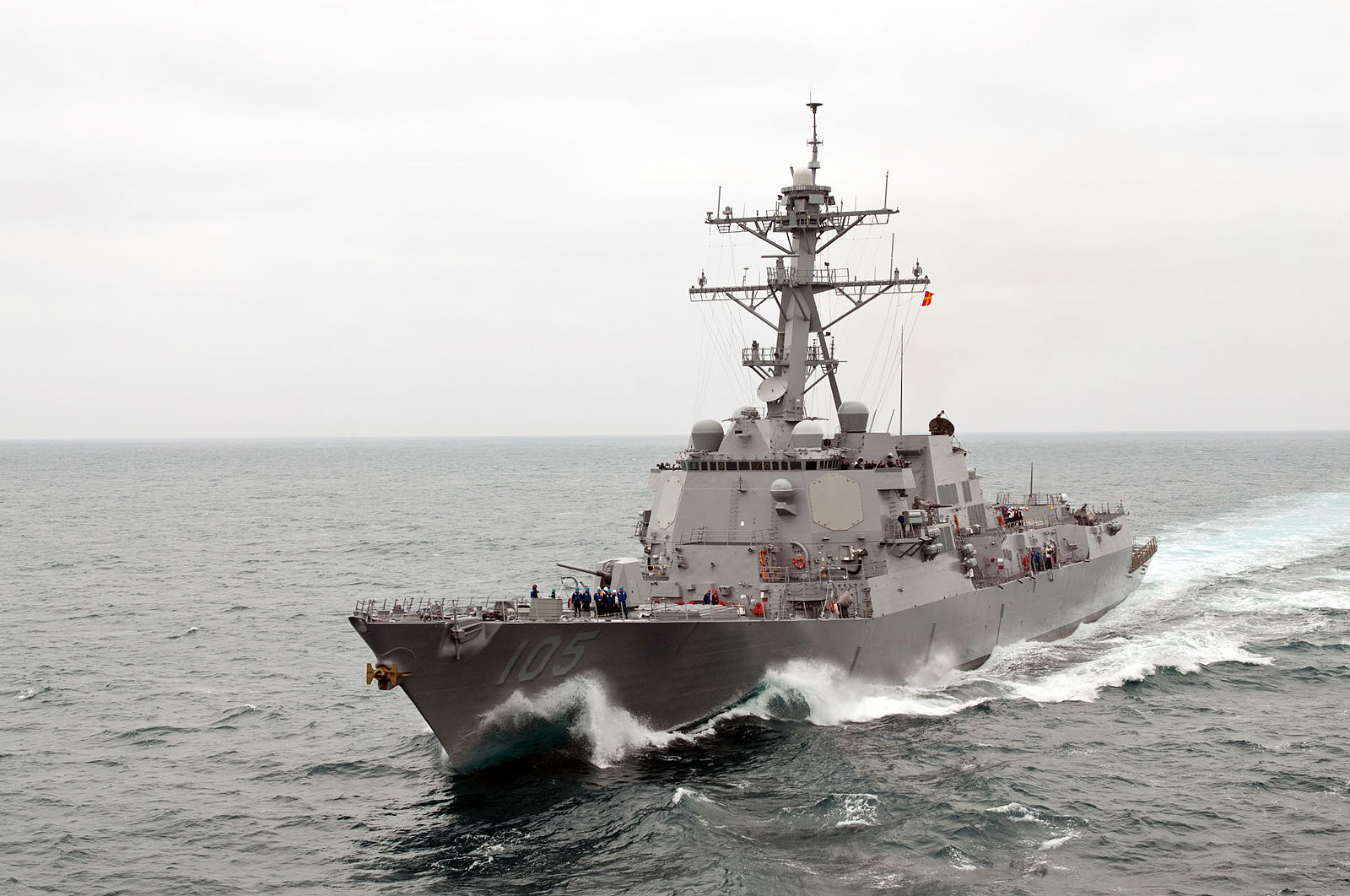Forget the FONOPs — Just Fly, Sail and Operate Wherever International Law Allows
On May 24, the guided-missile destroyer USS Dewey (DDG 105) operated within 12 nautical miles (nm) of Mischief Reef, a disputed feature in the South China Sea (SCS) controlled by the People’s Republic of China, but also claimed by the Philippines, Taiwan, and Vietnam. The Dewey’s action evidently challenged China’s right to control maritime zones adjacent to the reef —which was declared by the South China Sea arbitration to be nothing more than a low tide elevation on the Philippine continental shelf.

Published by The Lawfare Institute
in Cooperation With

On May 24, the guided-missile destroyer USS Dewey (DDG 105) operated within 12 nautical miles (nm) of Mischief Reef, a disputed feature in the South China Sea (SCS) controlled by the People’s Republic of China, but also claimed by the Philippines, Taiwan, and Vietnam. The Dewey’s action evidently challenged China’s right to control maritime zones adjacent to the reef —which was declared by the South China Sea arbitration to be nothing more than a low tide elevation on the Philippine continental shelf. The operation was hailed as a long-awaited “freedom of navigation operation” (FONOP) and “a challenge to Beijing’s moves in the South China Sea,” a sign that the United States will not accept “China’s contested claims” and militarization of the Spratlys, and a statement that Washington “will not remain passive as Beijing seeks to expand its maritime reach.” Others went further and welcomed this more muscular U.S. response to China’s assertiveness around the Spratly Islands to challenge China’s “apparent claim of a territorial sea around Mischief Reef…[as well as] China’s sovereignty over the land feature” itself.

But did the Dewey actually conduct a FONOP? Probably—but maybe not. Nothing in the official description of the operation or in open source reporting explicitly states that a FONOP was in fact conducted. Despite the fanfare, the messaging continues to be muddled. And that is both unnecessary and unhelpful.
In this post, we identify the source of ambiguity and provide an overview of FONOPs and what distinguishes them from the routine practice of freedom of navigation. We then explain why confusing the two is problematic—and particularly problematic in the Spratlys, where the practice of free navigation is vastly preferable to the reactive FONOP. FONOPs should continue in routine, low-key fashion wherever there are specific legal claims to be challenged (as in the Paracel Islands, the other disputed territories in the SCS); they should not be conducted—much less hyped up beyond proportion—in the Spratlys. Instead, the routine exercise of freedom of navigation is the most appropriate way to use the fleet in support of U.S. and allied interests.
What Did the Dewey Do?
According to Pentagon spokespeople, the Dewey entered within 12 nm of Mischief Reef at 7 a.m. local time on May 24. The destroyer then sailed in a zigzag pattern, at times navigating within 6 nm of the feature. The Dewey also conducted a “man overboard” rescue drill. The man overboard drill is the clearest suggestion that an intentional—and approved—FONOP occurred. What other reason is there to approach within 6 nm of Mischief Reef for a man overboard drill?
In response, the People's Liberation Army Navy (PLAN) quickly sortied guided-missile frigates Liuzhou and Luzhou to intercept and “expel” the Dewey, which remained within 12 nm of Mischief Reef for 90 minutes and repeatedly communicated with the PLAN vessels its intention to peacefully exercise navigational freedoms. The Dewey was plainly operating in a mode consistent with high seas freedoms, and not in the “continuous and expeditious” manner required of innocent passage through a claimed and accepted 12 nm territorial sea.
The Department of Defense statement issued shortly after the operation demands some further parsing since it expressly avoids stating clearly that the operation was a FONOP. Pentagon spokesman MAJ Jamie Davis informed the press in a written statement that “U.S. forces operate in the Asia-Pacific region on a daily basis, including in the South China Sea” and in so doing “demonstrate that the United States will fly, sail, and operate wherever international law allows.” The statement went on to note that the U.S. has a “comprehensive Freedom of Navigation Operations program,” but shares this information without connecting it to the Dewey’s operations. It did not confirm or deny that the operation was a FONOP. As Julian Ku noted here at Lawfare, other Pentagon officials speaking on the record would only state that FONOPs are ongoing. Summaries of all FONOPSs conducted each year will now be acknowledged only in an end-of-year report published by the Department of Defense.
What Is a FONOP?
Since 1979, the Defense and State Departments have jointly run the Freedom of Navigation program for the purpose of issuing formal challenges to other states’ explicit maritime claims. Such operations uphold the U.S. position that the coastal state claim in question is excessive as a matter of international law (see Roach and Smith’s Excessive Maritime Claims for an authoritative discussion of which claims are deemed excessive and why). The U.S. Navy’s FONOPs fulfill the Secretary of Defense’s role in undertaking activities in the area of the excessive claim that are consistent with international law, but inconsistent with the coastal state’s claim. The role of the State Department is to communicate the legal challenge to the target government, usually in a formal, written demarche. According to the official description, the fleet may also conduct “FON-related” activities, where a freedom of navigation challenge is a secondary effect of an operation with a different primary purpose. Such second-order FONOPs typically do not require interagency coordination and are executed within the military chain of command, unaccompanied by a diplomatic demarche. These “FON-related” activities are simply routine exercises of high seas freedoms that happen to have the secondary effect of strengthening the rule of law at sea.
Traditionally, FONOPs are operationally minimal and diplomatically low-key. The point is not to menace the offending state with gunboats or to upstage them with publicity. Rather, the program asserts the relevant legal norm in word and in deed. FONOPs are not primarily designed to send targeted signals of resolve, reassurance, commitment, deterrence, or any other of the many political-military signals the United States sends through its naval operations. A FONOP is a specialized tool to protect discrete legal norms that underpin the order of the oceans. This order is largely codified in the United Nations Convention on the Law of the Sea (UNCLOS) and is also widely accepted as customary international law. American FONOPs therefore do not just protect American freedoms—they protect the right of all states to benefit from the open oceans regime.
As detailed in the Pentagon’s annual reports, many claims are challenged around the world—including those of allies and partners. The map below (see the interactive version here) shows the location and relative frequency of FONOPs (represented by the size of the circle) since the Pentagon started publishing its data in 1991. The Asian littoral (running from the Sea of Japan to the Arabian Sea) is obviously the locus of this activity, as the region in which the majority of excessive claims are located. But the map makes clear that the program is global and targets competitor states and friends alike. FONOPs are purposively decoupled from other diplomatic initiatives specific to a state or region precisely because their purpose is to uphold a uniform set of norms for all of the world’s oceans.

How Is a Formal FONOP Different from the Routine Practice of Freedom of Navigation?
The Commander of the United States’ Pacific Fleet has repeatedly stated in his public addresses that vessels under his command spend an “average [of] 700 ship days a year … in the South China Sea.” That is, at any time on any given day of the year, one or two U.S. Navy ships are in the South China Sea. These ships undertake the full panoply of routine naval operations—exercising with other navies, maintaining a reassuring presence, gathering intelligence, protecting sea lines of communication, deterring conflict, and standing ready to intervene in times of crisis, among many others. Routine operations can send the full spectrum of political signals to allies, partners, and friends—and to potential foes—in support of the policies of the elected leaders of the U.S. government. They can even have the incidental effect of challenging an excessive claim. The key is that such operations make routine use of the full spectrum of existing freedoms.
Naval operations of this sort occur continuously across the globe, including in the South China Sea. As former Secretary of Defense Ash Carter put it, “the United States will fly, sail and operate wherever international law allows, as we do around the world, and the South China Sea will not be an exception.” Unlike a FONOP, which has a narrow legal purpose intended to challenge a specific legal claim made by a sole coastal state, routine naval operations perform a far broader set of political and strategic functions. The nature of these operations must be clear if their purposes are to be achieved.
So was the Dewey’s passage a FONOP designed to be a narrow legal challenge between the US and Chinese governments? Or was it a rightful and routine exercise of navigational freedoms intended to signal reassurance to the region and show U.S. resolve to defend the rule sets that govern the world’s oceans? Regrettably, the DOD spokesman’s answer was not clear. The distinction is not trivial.
What’s the Problem with Confusing FONOPs and Freedom of Navigation?
The U.S. should have undertaken, and made clear that it was undertaking, routine operations to exercise navigational freedoms around Mischief Reef—rather than (maybe) conducting a FONOP.
The first problem with conducting FONOP operations at Mischief Reef or creating confusion on the point is that China has made no actual legal claim that the U.S. can effectively challenge. In fact, in the Spratlys, no state has made a specific legal claim about its maritime entitlements around the features it occupies. In other words, not only are there no “excessive claims,” there are no clear claims to jurisdiction over water space at all. Jurisdictional claims by a coastal state begin with an official announcement of baselines—often accompanied by detailed geographic coordinates—to put other states on notice of the water space the coastal state claims as its own.
China has made several ambiguous claims over water space in the South China Sea. It issued the notorious 9-dashed line map, for instance, and has made cryptic references that eventually it might claim that the entire Spratly Island area generates maritime zones as if it were one physical feature. China has a territorial sea law that requires Chinese maritime agencies only to employ straight baselines (contrary to international law). And it formally claimed straight baselines all along its continental coastline, in the Paracels, and for the Senkaku/Diaoyu Islands, which China claims and Japan administers. All of these actions are contrary to international law and infringe on international navigational rights. These have all been subject to American FONOPs in the past—and rightly so. They are excessive claims. But China has never specified baselines in the Spratlys. Accordingly, no one knows for sure where China will claim a territorial sea there. So for now, since there is no specific legal claim to push against, a formal FONOP is the wrong tool for the job. The U.S. Navy can and should simply exercise the full, lawful measure of high seas freedoms in and around the Spratly Islands. Those are the right tools for the job where no actual coastal state claim is being challenged.
Second, the conflation of routine naval operations with the narrow function of a formal FONOP needlessly politicizes this important program, blurs the message to China and other states in the region, blunts its impact on China’s conduct, and makes the program less effective in other areas of the globe. This conflation first became problematic with the confused and confusing signaling that followed the FONOP undertaken by the USS Lassen in the fall of 2015. Afterward, the presence or absence of a FONOP dominated beltway discussion about China’s problematic conduct in the South China Sea and became the barometer of American commitment and resolve in the region. Because of this discussion, FONOPs became reimagined in the public mind as the only meaningful symbol of U.S. opposition to Chinese policy and activity in the SCS. In 2015 and 2016 especially, FONOPs were often treated as if they were the sole available operational means to push back against rising Chinese assertiveness. This was despite a steady U.S. presence in the region for more than 700 ship days a year and a full schedule of international exercises, ample intelligence gathering operations, and other important naval demonstrations of U.S. regional interests.
In consequence, we should welcome the apparent decision not to conduct a FONOP around Scarborough Shoal—where China also never made any clear baseline or territorial sea claim. If U.S. policy makers intend to send a signal to China that construction on or around Scarborough would cross a red line, there are many better ways than a formal FONOP to send that message. One such political signal that was well sent is the deployment of Third Fleet forces from San Diego to the Western Pacific to augment the U.S. Navy’s Seventh Fleet forces resident in Asia. On January 5, 2017, the Nimitz-class aircraft carrier USS Carl Vinson (CVN 70) and its carrier strike group (CSG 1) began a new “Third Fleet Forward” deployment pattern in the Western Pacific. The group conducted routine operations in the South China Sea and is now conducting exercises in the Asia-Pacific with allies and partners to demonstrate American commitment and to build partner combat capabilities. Official U.S. government statements were appropriately understated, noting that “[o]perating two carrier strike groups in the Western Pacific provides unique training opportunities for our forces and provides combatant commanders with significant operational flexibility should these forces be called upon in response to regional situations.” The Chinese foreign ministry acknowledged the activity without protest. These vessels were carrying out routine naval operations to send a clear signal to regional states about U.S. capabilities and intentions. This was a clear message, clearly received.
The routine operations of the fleet in the Pacific theater illustrate the crucial—and often misunderstood—difference between a formal FONOP and operations that exercise freedoms of navigation. FONOPs are not the sole remedy to various unlawful restrictions on navigational rights across the globe, but are instead a small part of a comprehensive effort to uphold navigational freedoms by practicing them routinely. That consistent practice of free navigation, not the reactive FONOP, is the policy best suited to respond to Chinese assertiveness in the SCS. This is especially true in areas such as the Spratly Islands where China has made no actual legal claims to challenge.




.jpg?sfvrsn=f557f72a_4)
